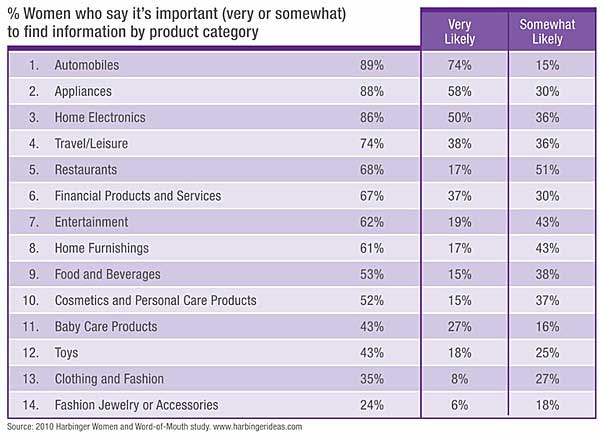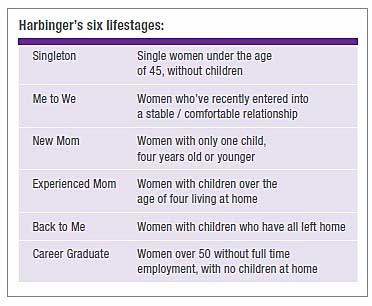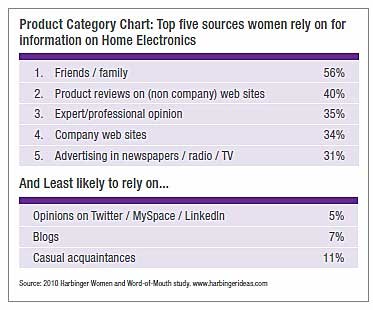Websites have now surpassed traditional forms of word-of-mouth as the preferred method among women for getting information about products and services, but when sharing information and opinions, women are still nearly three times more likely to do so with family and friends than to go online, according to a survey from Harbinger.
When sharing their opinions about products and services, 92% of women say they prefer face-to-face communications with family and friends over online methods. Even so, women use multiple channels to share information and opinions:
- Face-to-face with strangers or casual acquaintances: 36%
- Websites: 32%
- Facebook, MySpace, or LinkedIn: 27%
- Blogs: 11%
- Twitter: 7%
Below, other findings from the Harbinger Women Word-of-Mouth study, conducted by Ipsos.
Seeking and Sharing Information, by Product Category
Most women look for guidance before buying: Only 28% of surveyed women decide what products or services to buy without looking for some kind of help. But their approaches vary significantly depending on their lifestage and the type of product involved.
Overall, women are more active discussing products that involve larger investments or personal experiences—and less active discussing those involving strong personal tastes or lifestyle preferences.
Across product categories, women are the most likely to find information about automobiles (89%), appliances (88%), and home electronics (86%)—and the least likely to find information about clothing and fashion (35%) and fashion jewelry or accessories (24%).

Similarly, women are the most likely to share information about appliances (80%), restaurants (78%), cars (74%), and entertainment (72%), and the least likely to share information about toys (34%), baby care products (32%), and fashion jewelry or accessories (30%).
Seeking and Sharing Information, by Lifestage
To study further differences in word-of-mouth practices among women, Harbinger defined six distinct lifestages:

New Moms are the most likely to go online first for product information, before turning to family and friends, whereas Back to Me women are the most likely to look to family and friends first, before going online.
Looking for great digital marketing data? MarketingProfs reviewed hundreds of research sources to create our most recent Digital Marketing Factbook (May 2010), a 296-page compilation of data and 254 charts, covering email marketing, social media, search engine marketing, e-commerce, and mobile marketing. Also check out The State of Social Media Marketing, a 240-page original research report from MarketingProfs.
Case Studies: Auto, Home Electronics
When considering an automobile purchase, Me to We women are the most likely to look for car information (93%), followed by Experienced Moms (92%) and New Moms (90%). However, Experienced Moms are the most likely to share information on cars (79%), followed by Back to Me (74%) and Career Graduates (74%).
When looking for car information, 64% of all surveyed women say they ask friends and family first, followed by seeking expert/professional opinions (50%) and product reviews on non-company websites (45%).
Though 41% of women say they read online reviews about cars, just 6% write such reviews.
Meanwhile, Experienced Moms are the most likely to seek information about home electronics goods (88%), followed by Me to We (87%) and New Moms (86%). Experienced Moms are the most likely to share information about home electronics (74%), followed by Me to We (71%) and New Moms (67%).
When buying home electronics, women rely more on family and friends (56%) and online product reviews (40%), and less on social networks (5%) and blogs (7%).

Home electronics is the top category for reading online reviews: 61% of women say they read online reviews about home electronics products, and 22% write such reviews.
About the data: The Harbinger Women and Word-of-Mouth study surveyed 2,134 women in the US and Canada via the Ipsos online panel, March 22-26, 2010. See product category profiles and research highlights for all product categories included in the Women and Word-of-Mouth study.



